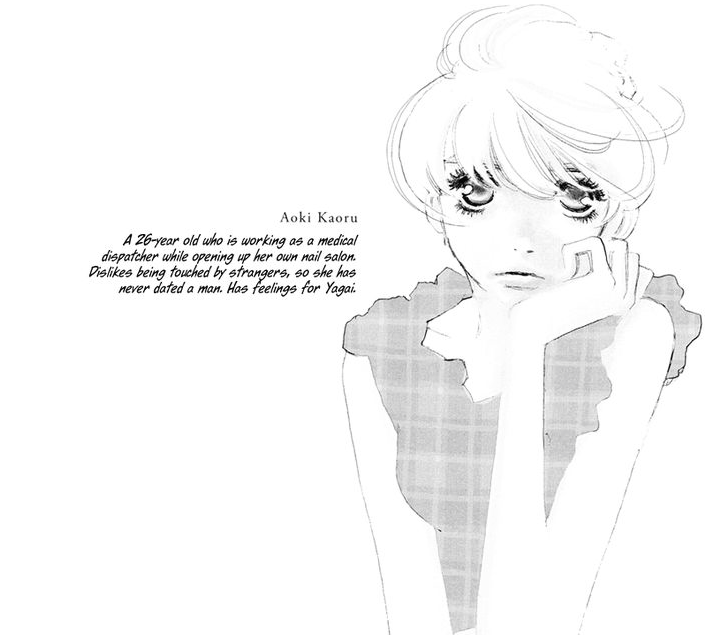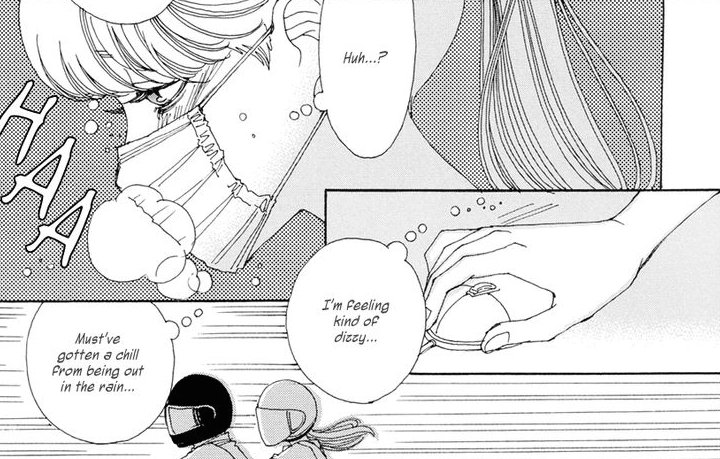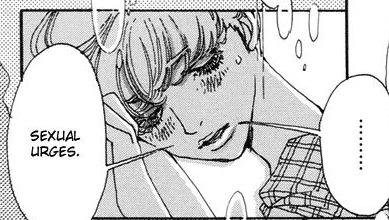Okazaki Mari’s romance comic “&” is about romance as a connection that springs from sensual experience. Its heroine, Kaoru, works in a hospital and is attempting to build her own business as a nail technician in her own time, and at the site of each job, she has a suitor.
The host of her nail business is a younger man she knew at university; they were in a club together despite being in different years, and her status as his senior can’t really be detached from his attraction to her. Once, when out together with their club, she fell asleep drunk on his lap on a bench at night—a tenting scar on his psyche that keeps him silently reserved in their friendly post-university acquaintance. Kaoru has no idea he likes her that way.
At the hospital, the object of her attraction is Yagai, a older genius surgeon and general bum; he’s all regret, bad decisions, and horniness. The majority of “&” is their dance around each other, with nail boy in the background to provide contrast and context: Yagai wants Kaoru to admit that she wants him to act tenderly towards her because she wants to bang him; she wants him to admit that the source of his desire to bang her is tenderness. Neither are completely honest or dishonest in quite the ways they claim, and both are inspired to lusty affection by the other.

“&” is a very good sexual romance comic because Okazaki has such a firm handle on the evocation of balance. She knows how to say enough, hold back from saying too much, and she knows how to hint at larger themes to balance the overt behaviour of her characters. For example, the excerpt below (read right to left). This is a story about fuuuuuuhhhhhking.
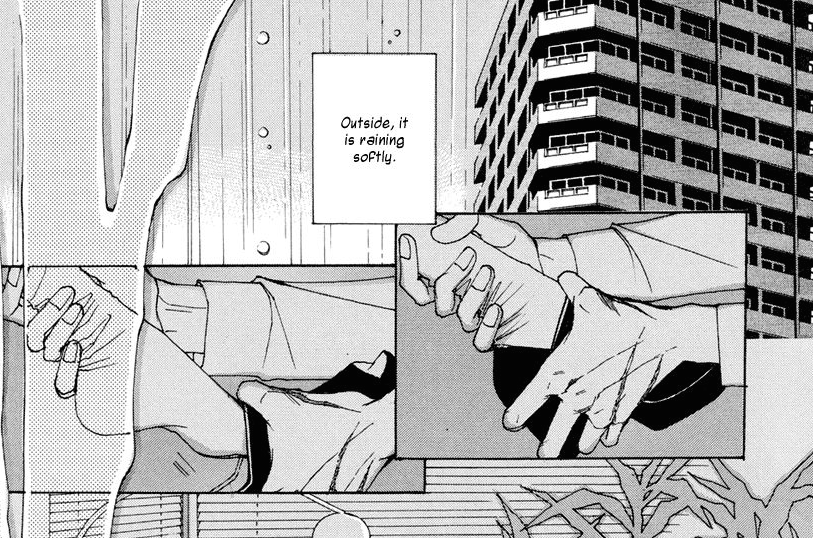
Okazaki is concentrating on the duality of affection and arousal. She’s writing a story from and for a feminine, and feminist, perspective. Looking closely at the hands of the lover, the delicacy of his touch (the juxtaposition of his scars and taut knuckles with his cupping support of her ankle), allowing the reveal of her body to matter, because it’s her body and he’s getting to see it—these are details that matter, when sex is created for consumption. The arch of her foot is a very sensitive and rarely seen area: it’s open to him. This scene tells us everything, which is he can have her if he wants. All it would take is trying, and she’d like it.
And then he jogs the fit of the shoe just enough that the shape of it, made for her foot, gets emptied and gapes for the loss of her. He flexes the leather to free her. He eases her out. Do you see how this is sexual?
At this point in the story, heroine has, in classic form, been out in the rain. Now she’s ill! Ah, the brattish, brooding hero must prove he has a baseline decency after all, taking her to safety and ensuring she sees care. He will tenderly—yes—comfort her fevered body. Knowing their existing relationship, knowing her response to his body and proximity, this is a lovely if fretful time for our heroine. It’s bittersweet because he’s being a doctor, not a lover, but it’s something she can relax into. She has permission—internal, external, permission from him, the standoffish prize she’s chasing —to be there with him, because she fainted in the street. It’s alright for her to be flushed and weak, because she has a fever. She’s in his own flat, where he chose to take her, because he wanted to look after her. And he’s not going to have sex with her, because he’s not a rapist. The circumstances for her comfortable consent are perfected: virginal and afraid of touch, she can want it and not get it, before she has to deal with wanting it and getting it.
But that means that the scene is ripe for erotic sensuality on her part. It’s not wrong for somebody to trial-run some of the emotions and interpersonal impressions of a sexual encounter while they’re being rescued by their fine-ass prince. And it’s not wrong for a cartoonist to symbolise the give and take of arousal, sex, or bodily contact in scenes that don’t actually go there.
Outside, it is raining softly. Inside it’s raining softly too, huh? The drip and slip of that windowpane is an intimate pathetic fallacy. It runs down her leg, literally, visibly, without being literally literal. And the shoe: the removal of that shoe says more about sex than a whole lot of comics can hope to. It would be a very different scene if he were dressing her.
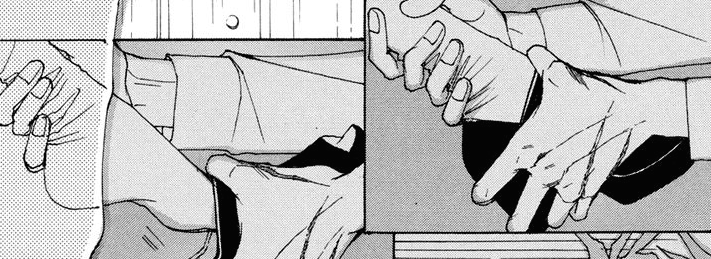
In heteronormative sex—this is a heteronormative relationship, a heteronormative comic—it’s all about the D “going into” the V Right? We have this narrative set up and ready to go. You stick the dick into the waiting vagina, and that’s that: That’s sex, you’ve done sex. What next? Who cares? You did it. Alright! It’s a narrative, but it’s not a complete one, is it?
Even if your everyday, Ace Venture crotch pumping, macho masculine cisgendered pleasure-centric rutting, the cock needs to come out of the puss at least a little bit. If it doesn’t come out, it can’t go back in again. You’re just stuck, like dogs, and that’s for Teen Wolf fic, not career-woman romance manga. Or real life. Eroticised withdrawal is a necessary facet of Full Sex because the ability to move forward in glory, but not back in it is obviously limiting; if you want an sensual, luxurious, gratifying experience you don’t want it broken up into the modular plays of an American Football match, hot/not/hot/not/hot/not every second or half-second. The ability to pull back as a part of the expression of your hunger, for the whole motion of orifice stimulation and physical contact to be a part of the game, is to be erotically empowered. If you have a hole, your fantasy sexual scenarios should cover whatever you want to do with it, and if the fantasy is being bought (like a comic is) then wherever you want to move your hole should be overtly validated as a part of the arousing construct.
For Okazaki to place the shoe in the hands of Yagai is masterful construction, because it’s a second saw against the grain. Drawing your “shoe” from a “foot,” even when empowered as eroticised withdrawal, is a symbolically feminine motion. Because of the feminine assumption of vaginal genitalia, but because of the assumption of submission that attends femininity too—because vaginas “get fucked” and woman “have vaginas,” women must “get fucked” (buckle under the dominance of a masculine presence) even if they don’t have vaginas. A vagina, “a pussy,” is used to suggest feminine weakness and submission even when the accused is acknowledged to lack one. Essentially calling her romantic lead a pussy in a scene that sexually gratifies her heroine, is Okazaki telling you that male/female strong/weak binaries and traditionally gendered roles are to be interrogated? The premise of her comic is not so simple as “stupid girl falls for aged-up bad boy.”
Yagai taking this role, becoming the shoe holding vagina-haver, allows the reader to infer some leveling of their private playing field. He’s taken her to his house to look after her, able to be tender, he’s vulnerable, he’s being affected by her in ways he’s uncomfortable with. It casts his masculine romantic reluctance in a feminine light: He’s like this (grumpy, prone to rejection, rude, bossy), because he’s upset. He’s upset, because he’s not “enough of a man” to not be. He’s not enough of a man, because there’s no such thing. In love, in sex, and in life, men may hold more social power, but they are not actually safe from their humanity.
In casting the man in a woman’s archetype, the woman’s role and persona take on an adaptive masculinity, a comparative equality, and through this (through the inescapability of patriarchal power structures and thought shapes) is subconsciously validated, and meta-narratively emboldened. Kaoru seems stronger for her weakness now that Yagai’s “strong” faults are informed by emotion and outside influence. The story is about both of them: Their romance, their sexual contact, will live or die by their combined actions, their shared responsibility. Despite the vast differences in their life experiences, they are narrative equals in their love “&” sex story.


